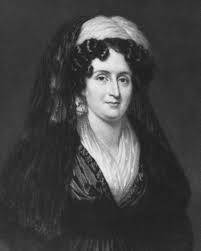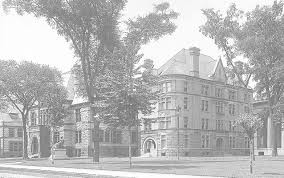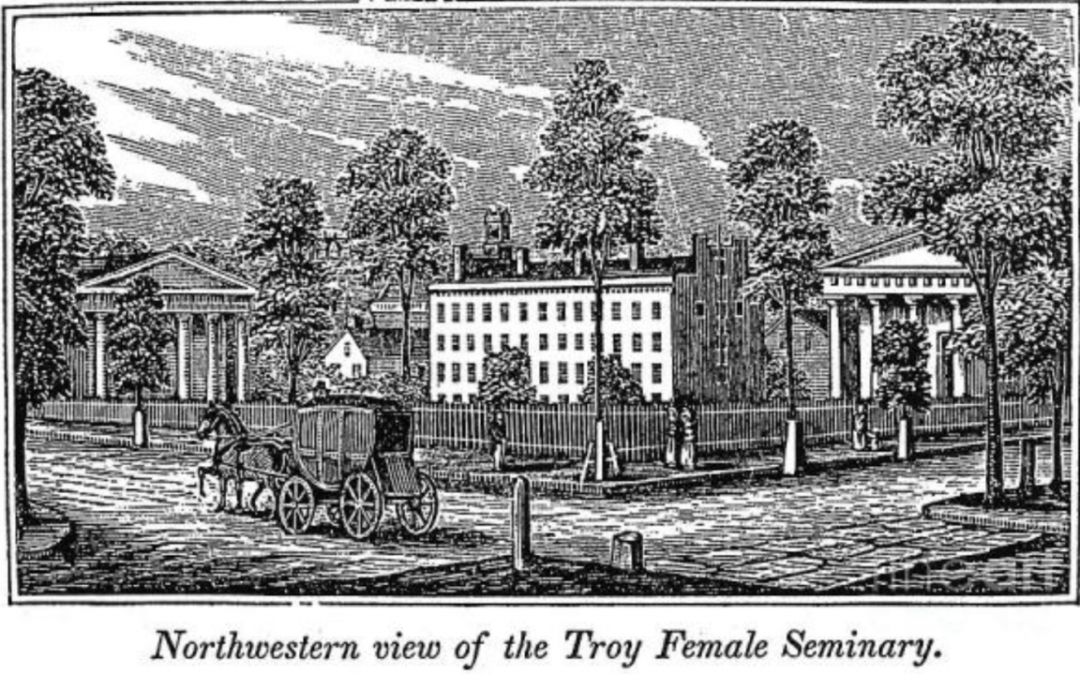by
_____
Two hundred years ago, that wasn’t a ridiculous question.
In fact, most people back then believed education was wasted on girls and young women, since their role in life was to take care of their husbands and children.
Emma Hart Willard disagreed. She believed women were intellectually equal to men, and she used her public voice to speak out for their education. In 1814 she founded the Troy Female Seminary in upstate New York, the first institution of higher education for women in the US.
She also began working on a document. Three years later, in 1819, Willard delivered an address to the New York State Legislature in Albany. Because women seldom spoke in public, she had someone else read her remarks.
Her address was a strategically drafted, powerfully-constructed piece of rhetoric, laying out not just the rationale for women’s education, but a detailed plan for what that institution would look like: how it would be structured, what the coursework would include, how students would be taught. And she argued that public funds should support it.
Willard was a trailblazer in women’s education, and her brilliant speech has been called “the Magna Carta of the higher education of women in America.”
Unfathomably, Willard’s words have been all but forgotten. Her speech is not included in any anthology I’ve come across. It’s not on anybody’s list of historic speeches. That’s why I’m so pleased to include it in Speaking While Female, the first-ever web-based collection of women’s public rhetoric from around the world and across time.
Willard began working on her address while she was living in Middlebury, Vermont, across the street from the campus of the highly-respected Middlebury College, a male-only institution founded in 1800. At that time there was no college in the world that admitted women.
Although Willard was raised by parents who valued education for both their daughters and sons, and although she attended to public school, her classes met for only 12 weeks in the wintertime. That wasn’t unusual. For most American girls, education stopped at grade school. The daughters of families with means were trained in the so-called “accomplishments — painting, drawing, dance and music.
In 1814, Willard tried to enroll in Middlebury College. When her application was rejected, she wrote to a friend that she was furious “about the disparity in educational facilities between the two sexes.”
Her anger and frustration became the impetus for her petition to the legislators requesting state funds for a women’s seminary.
Appealing to the legislators’ patriotism, enlightenment, and good reason, she argued that educating women was in the best interest of the men, society, and the nation. She pointed out that well-educated women make better teachers, wives, and especially, mothers: “In this character, we have the charge of the whole mass of individuals, who are to compose the succeeding generation…”
A canny persuader, she played to the ego of the male legislators by calling them “enlightened citizens.” And in a move surely made with fingers crossed behind her back, she described the men as “our natural guardians,–our brothers,–our fathers, and our rulers,” and women as “the weaker sex,” with “ductile minds.”
In any case, her arguments impressed only some of the lawmakers — most seemed convinced that equal education would destroy the American family by encouraging women to leave their husbands, their children, and their homes.
The Senate voted to give the school $2,000, but the Assembly rejected the measure. The New York State board of education also refused to give money.

That’s when Willard decided to publish a pamphlet drawn from her speech, called “An Address to the Public, Particularly to the Members of the Legislature of New-York, Proposing a Plan for Improving Female Education.”
Although the state legislature continued to deny her money, she found the money she needed. Eventually the city council in Troy, New York, appropriated $4,000 to buy a three-story building for Willard to found her school, and the citizens agreed to raise enough money to renovate it.
In the autumn of 1821, Willard opened the doors of the Troy Female Seminary — the world’s first academy for women, and the first to teach women science, philosophy, history, and other subjects previously reserved for men. Today it’s known as the Emma Willard School.

Her school became the first to offer scholarships for intellectually gifted students who could not afford education. Over the years, Willard personally loaned about $75,000 of her own money — in those days a tremendous amount — to needy pupils who promised to go into teaching.
Willard continued to teach students and train teachers. She wrote textbooks, including a groundbreaking geography text that included maps that, for the first time, linked geography to history.

In later years, she turned the school over to her son and daughter-in-law. She traveled widely to speak in public about equal education, train teachers, and help communities set up public schools. In the 1840s she lectured in the southern and western United States, and in 1854 she represented the US at a conference for educators in London. She died in 1870.
But Willard’s mission is not yet complete. According to UNESCO, millions of girls around the world do not have access to education. Countries where girls have the least educational opportunity are Somalia, Niger, Liberia, Mali, Burkina Faso, Guinea, Pakistan, Yemen, Benin, and Cote d’Ivoire.
This is a tragedy. Sadly, not enough people are following Willard’s example and speaking out about it.
Willard displayed rare strength of character and confidence. She was unafraid to step onto the public stage and use her voice in a male-dominated world. She was scorned and ridiculed for it, but she understood the force of her words.
By remembering them, we enlarge our own sense of power and possibility.
© Copyright 2019
________________________________
Want to talk? Reach me at dana@danarubin.com

